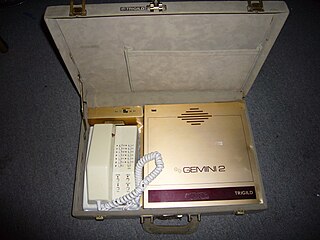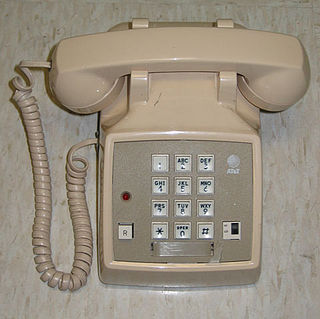
A telephone switchboard is a telecommunications system used in the public switched telephone network or in enterprises to interconnect circuits of telephones to establish telephone calls between the subscribers or users, or between other exchanges. The switchboard was an essential component of a manual telephone exchange, and was operated by switchboard operators who used electrical cords or switches to establish the connections.
In telecommunication, an automatic callback is a computer telephony calling feature that permits a user, when encountering a busy condition or other condition where the called individual is unavailable, to instruct the system to retain the called number and to establish the call when there is an available line or when the called number is no longer busy. Automatic callback may be implemented in the terminal, in the telephone exchange, or shared between them. Automatic callback is not the same as camp-on.
Phreaking is a slang term coined to describe the activity of a culture of people who study, experiment with, or explore telecommunication systems, such as equipment and systems connected to public telephone networks. The term phreak is a sensational spelling of the word freak with the ph- from phone, and may also refer to the use of various audio frequencies to manipulate a phone system. Phreak, phreaker, or phone phreak are names used for and by individuals who participate in phreaking.
A dial tone is a telephony signal sent by a telephone exchange or private branch exchange (PBX) to a terminating device, such as a telephone, when an off-hook condition is detected. It indicates that the exchange is working and is ready to initiate a telephone call. The tone stops when the first dialed digit is recognized. If no digits are forthcoming, the permanent signal procedure is invoked, often eliciting a special information tone and an intercept message, followed by the off-hook tone, requiring the caller to hang up and redial.
Operator assistance refers to a telephone call in which the calling party requires an operator to provide some form of assistance in completing the call. This may include telephone calls made from pay phones, calls placed station-to-station, person-to-person, collect, third number calls, calls billed to a credit card, and certain international calls which cannot be dialed directly. The telephone operator may also be able to assist with determining what kind of technical difficulties are occurring on a phone line, to verify whether a line is busy, or left off the hook, and break in on a phone line to request for the caller to clear the line for an incoming call. The latter service is often utilized by emergency police. In addition, operators are often a first point of contact for the elderly wanting information on the current date and time.

A telephone call is a connection over a telephone network between the called party and the calling party.
Phone fraud, or more generally communications fraud, is the use of telecommunications products or services with the intention of illegally acquiring money from, or failing to pay, a telecommunication company or its customers.

A business telephone system is a multiline telephone system typically used in business environments, encompassing systems ranging from the small key telephone system (KTS) to the large private branch exchange (PBX).

The Improved Mobile Telephone Service (IMTS) was a pre-cellular VHF/UHF radio system that links to the PSTN. IMTS was the radiotelephone equivalent of land dial phone service. It was introduced in 1964 as a replacement to Mobile Telephone Service or MTS and improved on most MTS systems by offering direct-dial rather than connections through a live operator.
Simplified Message Desk Interface (SMDI) is a protocol that defines the interface between a voice mail system and a phone system such as a PBX or public telephone switch. It was developed by Bell Labs. It is used to provide the voice mail system the information it needs to process the call. Each time a call is sent to the voice mail system, a message is sent using SMDI over a serial interface that identifies the line, the type of call, and the calling/called party numbers. The SMDI protocol also specifies a method for turning the message-waiting indicator (MWI) on and off on individual telephones.
Phreaking boxes are devices used by phone phreaks to perform various functions normally reserved for operators and other telephone company employees.

The 1A2 Key Telephone System is a business telephone system developed and distributed by the Western Electric Company for the Bell System.
The Number Five Crossbar Switching System is a telephone switch for telephone exchanges designed by Bell Labs and manufactured by Western Electric starting in 1947. It was used in the Bell System principally as a Class 5 telephone switch in the public switched telephone network (PSTN) until the early 1990s, when it was replaced with electronic switching systems. Variants were used as combined Class 4 and Class 5 systems in rural areas, and as a TWX switch.
A request line or contest line is a telephone line which allows listeners to a radio station to call the radio studio or TV studio directly. In radio, this is usually to request a song, win a contest, be a part of a talk show, or to ask a question of the disk jockey, such as what the name and artist of a recent song was. Used occasionally in television, it is typically for telephone voting for an unscientific opinion poll in relation to news events, for a talk show, or sometimes to win a contest.
Call management is the process of designing and implementing inbound telephone call parameters, which govern the routing of these calls through a network. The process is most prominently utilized by corporations and the call centre industry and has its highest effectiveness when call logging software tools are used. Calls are routed according to the set up of calling features within the given system such as Call queues, IVR menus, Hunt groups and Recorded announcements. Call features provide a customised experience for the caller and maximize the efficiency of inbound call handling. Call management parameters can specify how calls are distributed according to an operator's skill level in relation to a call, the time and/or date of a call, the location of the caller or through automatic routing processes.

A telephone exchange is a telecommunications system used in the public switched telephone network or in large enterprises. An exchange consists of electronic components and in older systems also human operators that interconnect (switch) telephone subscriber lines or virtual circuits of digital systems to establish telephone calls between subscribers.
Telephone number verification services are online services used to establish whether a given telephone number is in service. They may include a form of Turing test to further determine if a human answers or answering equipment such as a modem, fax, voice mMail or answering machine.

The Panel Machine Switching System is an early type of automatic telephone exchange for urban service, introduced in the Bell System in the 1920s. It was developed by Western Electric Laboratories, the forerunner of Bell Labs, in the U.S., in parallel with the Rotary system at International Western Electric in Belgium before World War I. Both systems had many features in common.









